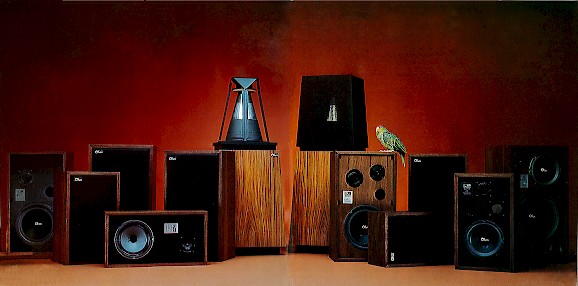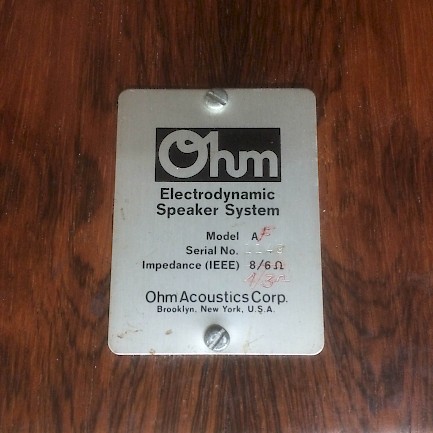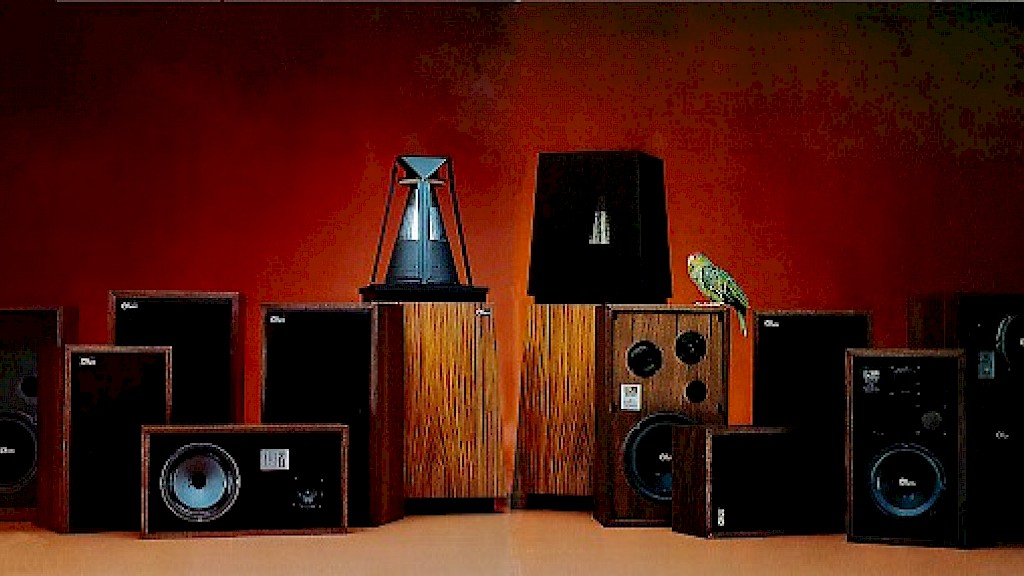Your Ohm or Mine? Identifying Legacy Ohms
This week I received a call from a woman who had inherited a pair of Ohms from her uncle. She fondly remembered listening to them as a child and wanted to be certain they were working correctly. First, we needed to know what model she was using… This is not an unusual problem; people call for help in identifying older Ohms every week. There are many Ohms in use and knowing the model is critical to learning about their potential performance (and market value).

We need your help in getting all Ohm Owner’s Manuals and other documentation up on our website. If you have a Legacy Ohm, please check in our Legacy Parts and Service section (under SHOP) to see if we have the Owner’s Manual of your model (it would be both under the Specifications section and in the Documents section at the bottom of the page). If you have any documentation that is not posted, we would very much appreciate a call at 800-783-1553.
Are you are considering buying a legacy Ohm? There is a big difference in performance and value from model to model. I have seen Ohms on eBay for under $100 and for over $10,000. In the last forty years Ohm made over one hundred thousand traditional (and non-traditional) box speakers. Most of them are still in use today. We also have made over ten thousand pairs of Walsh speakers in that time and continue to make new ones every day. We support all these speakers. For every model, we have (or are prepared to design) repairs or upgrades – yes, every model.
What models do you own or are considering purchasing?
Box Speakers (1972-1999)
With most of the box speakers Ohm put model labels either on the back or behind the front grill. You can easily confirm the model by going to our website’s Legacy Parts & Service section. Plug in the Product Name and you usually see a picture of the speaker. Click on the picture and all the information we have about that product comes up. If you cannot find the product label, get the size of the box (width, height and depth) plus the size of the woofers and tweeters and give us a call at 800-783-1553. We can usually help you out.
With the Walshs, determining the model can be a quite a bit trickier as we have been improving them for over 40 years. There are many upgraded older models in use, mixed with originals. I believe our website has missed some upgrades and prototypes. If you believe you have an Ohm speaker not listed on our website, please work with us to complete the documentation.
The First Generation of Walsh Speakers (1972-1981)
The original Ohm A is quite distinctive with its exposed 18” inverted driver on a pyramid shaped cabinet 23” wide at the widest (near the base) and tapering to about 15” at the top of its grill. The Ohm As usually have a model/serial number plate on the bottom rear of the speaker. The Ohm F looks like a slimmer version with its 12” driver and 17” cabinet. They also usually have a model/serial number plate on the back (some very early prototype Ohm Fs had Ohm A plates with a “2” stamped into the plate after the Ohm A. For a while we planned to call the Ohm F the Ohm A2 as we had done in the box speakers). The Ohm G looks more like a box speaker. If you remove the front grill, you will see the small, 8” inverted driver.

The Second Generation of Walsh Speakers (1981-present)
All the subsequent Walsh models, from the Walsh 2 to the current Walsh 5000 all use new inverted drivers and super-tweeters mounted inside protective perforated metal cans. The first two series of this Walsh family (Walsh 2-Walsh 5LE [Limited Edition] and Walsh 1XO-Walsh 4XO) used the pyramid cabinets with the driver mounted on top of the cabinet. Like the Ohm A and Ohm F, the new Walsh drivers had cloth grills for cosmetics.
The Walsh 1 and Walsh 2 used the same cabinet with the Walsh 1 having an Ohm logo on the grill and no controls on the bottom of the cabinet. The Walsh 2 has an Ohm logo at the top right corner of one side and a Walsh 2 logo at the top left corner of the adjoining side. The Walsh 2 also has controls and the input on the bottom. The Walsh 3 is two inches bigger (in each direction) than the Walsh 2 (with logos in similar corners). The Walsh 4 is about another 2” larger and has the Ohm logo on the front, toward the bottom. Walsh 4 controls/inputs are on the rear panel. The Walsh 5 is the biggest (by about 2”) and has the same placement of logo and controls/input as the Walsh 4. The Walsh XO (for eXtra Output) series have the same cabinets and logo placement as the Walsh 2 series. The Walsh XOs did not have any controls. There was no Walsh 5XO; but the Walsh 4.9 was created without controls and was more-or-less balanced for maximum output and was an unlimited production run.
Full Room Stereo and Sound Cylinders (1982-1989)
The Full Room Stereo (FRS-11 & FRS 15) have the current style perforated can/driver. The cabinets for these FRS models are unusual in that they have their vertical corners cut at a 45 degree angle with the Ohm logo on one of these corners. Ohm Sound Cylinders all use cylindrical cabinets as their name implies. The original six models in the Sound Cylinder series and the current Super Sound Cylinder 4900 all also use this style perforated can/driver. The original Sound Cylinders were all 11.5” in diameter while the current Super Sound Cylinder 4900 is 12.5” in diameter. Each Sound Cylinder model was a specific height. You can find them in the Legacy Parts & Service.
Subscribe to Ohm News & Views to get the latest posts in your inbox
Walsh Speakers by the Numbers
The Walsh Hundred, Hundred Mark-2, Hundred Series-3, the MicroWalsh, the MicroWalsh Signature Edition, the FRS-11&15 and the current Thousand series all use vertical columns. The Walsh Hundred and Hundred Mk-2 all have rectangular horizontal cross sections with the long sides about four inches greater than the short sides. The remaining four series all have square horizontal cross sections about equal to the short sides of the earlier series. The Walsh Hundred, Hundred S-3 and the MircoWalsh series all have sharp corners while the Walsh Hundred Mk-2, MicroWalsh SE and the current Thousand Series all have rounded vertical corners.
The following are the approximate diameters of the perforated can/driver assembly and the approximate widths of the shortest side of the cabinets of these series:
| Can: | Side: | Models: |
| 5” | 6” | MicroWalsh and MicroWalsh SE |
| 6” | 8” | Walsh 1000 |
| 7” | 10” | Walsh 1, Walsh 2, Walsh 1XO, Walsh 2XO, Walsh 100, Walsh 100 Mk-2, Walsh 100 S-3, Walsh 2000 |
| 9” | 11” | Walsh 3, Walsh 3XO, Walsh 200, Walsh 200 Mk-2, Walsh 200 S-3, Walsh 3000 |
| 9” | 13” | Walsh 4, Walsh 4XO, FRS-11, FRS-15 |
| 11” | 14” | Walsh 300, Walsh 300 S-2, Walsh 4.9, Walsh 5, Walsh 5 MK-2, Walsh 5 S-3, Walsh 4000, Walsh 5000 |
I realize I have given more information than anyone wants. And I have not yet addressed Upgrades, Beta version, Subwoofers and Satellites…
So, I am taking a break and will cover some of the missing pieces some other time. Do feel free to call me personally about your Ohms, their documentation or Ohms you are considering buying,
John
800-783-1553
John Strohbeen Author
John Strohbeen was the President and Chief Engineer of Ohm Acoustics from 1978-2023.


